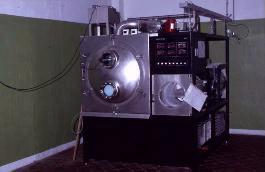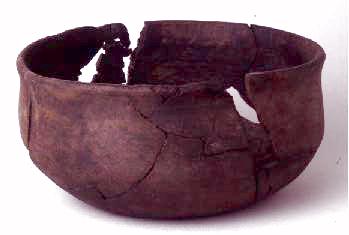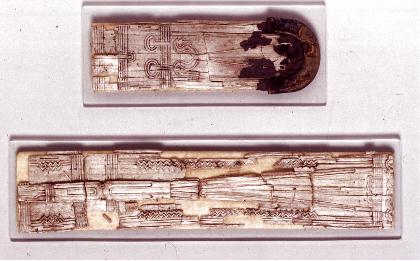
About 800 kilo of waterlogged wood is loaded on a wooden pallet and moved into the 7.5m long vacuum tank
We have conserved antiquities in Denmark by freeze drying since 1979, when equipment was installed in the National Museum to freeze dry from tertiary butanol, which solidifies at 25 degrees C.
The objects are first impregnated with PEG 4000 dissolved in butanol (an alcohol like molecule). During this process the original water diffuses out of the wood, because it is miscible with butanol. The butanol is then removed by freeze drying. The butanol passes directly from the solid to the vapour state, avoiding the liquid state, where surface tension would cause collapse of the wood structure during evaporation. The results have been good, in spite of the poor penetrating power of PEG 4000. The method was used in the National Museum for ten years but was abandoned in 1992, because it is slow and is also a health risk.
The preferred method, at present, for conserving very decomposed wood, such as Iron Age wood from bogs, is impregnation with PEG in water solution, followed by freeze drying. A mixture of PEG's of different molecular sizes is often used to give a combination of depth of impregnation and strength. Impregnants such as sucrose (sugar) and glucose are useful for wooden objects with metal parts which corrode in PEG solution.
Thin pieces and severely decomposed pieces of wood can be impregnated in half a year. Thicker and better preserved wood needs to lie in the bath up to ten years before it is thoroughly impregnated. After impregnation, the object is freeze dried. This takes from 3 to 5 months.

About 800 kilo of waterlogged wood is loaded on a wooden pallet
and moved into the 7.5m long vacuum tank

Modern equipment for freeze drying waterlogged antiquities

Iron Age bowl. Freeze dried after impregnation with PEG 200 and
PEG 2000, in 1994

Iron Age scabbard. Impregnated with sugar and a very little glycerin
and freeze dried in 1994
Occasionally, selected objects are treated by dehydration from solvents: cellosolve and petrol. The principle of the process is that the cellosolve is miscible with water and slowly replaces it as the object is heated in a bath of cellosolve to evaporate the water. The cellosolve is in turn replaced by petrol. This can them be allowed to evaporate from the wood. There is no collapse because the water-free wood is stiff even when it is full of petrol. The method is fast. Objects conserved in this way are pale and light. The disadvantage of the method is that the organic vapours are poisonous. It is useful for objects containing both wood and iron, which corrodes in the PEG bath.

Iron Age knife. Conserved with cellosolve and petrol in 1991